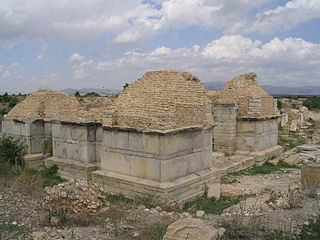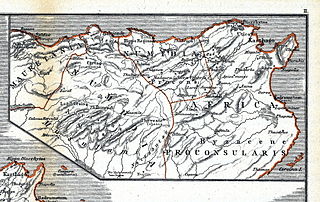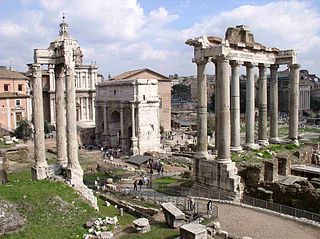
The Third Punic War was the third and last of the Punic Wars fought between the former Phoenician colony of Carthage and the Roman Republic. The Punic Wars were named because of the Roman name for Carthaginians: Punici, or Poenici.

Numidia was an ancient Berber kingdom of the Numidians, located in what is now Algeria and a smaller part of Tunisia and Libya in the Berber world, in North Africa. The polity was originally divided between Massylii in the east and Masaesyli in the west. During the Second Punic War, Massinissa, king of the Massylii, defeated Syphax of the Masaesyli to unify Numidia into one kingdom. The kingdom began as a sovereign state and later alternated between being a Roman province and a Roman client state. It was bordered by Atlantic ocean to the west, Africa Proconsularis to the east, the Mediterranean Sea to the north, and the Sahara Desert to the south. It is considered to be one of the first major states in the history of Algeria and the Berber world.
Byzacena was a Late Roman province in the central part of Roman North Africa, which is now roughly Tunisia, split off from Africa Proconsularis.

The name Early African Church is given to the Christian communities inhabiting the region known politically as Roman Africa, and comprised geographically within the following limits, namely: the Mediterranean littoral between Cyrenaica on the east and the river Ampsaga on the west; that part of it that faces the Atlantic Ocean being called Mauretania. The evangelization of Africa followed much the same lines as those traced by Roman civilization.
Usilla or Usula was a town in the Roman province of Byzacena, now Inchilla in Tunisia.

Thelepte was a city in the Roman province of Byzacena, now in western Tunisia. It is located 5 km from the modern town of Fériana, near the border with Algeria, at around 34°58′33″N8°35′38″E.
M'daourouch is a municipality in Souk Ahras, Algeria, occupying the site of the Berber-Roman town of Madauros in Numidia.

Assuras, sometimes given as Assura or Assur, was a town in the Roman province of Proconsular Africa.
Thucca was a town in the Roman province of Mauretania Sitifensis. Pliny the Elder describes it as "impositum mari et flumini Ampsagae", and thus on the border with Numidia.

Segermes is an ancient town in Tunisia. Under the Roman Empire, the city belonged to the province of Byzacena. The town is identified with ruins at Henchir Harat, Zaghouan( 36° 20′ 43″ N, 10° 18′ 03″ E).
Tabbora was a town in the late Roman province of Africa Proconsularis. The Catholic diocese that had its seat there was a suffragan of Carthage, the capital of the province.

Tubunae was a Roman-Berber city in Algeria. It is believed to have been in either ancient Mauretania Caesariensis and/or Numidia.

Téboursouk is a town and commune in the Béja Governorate, Tunisia. It is located at 36° 27′ 26″N, 009° 14′ 54″E.

El Alia is a town and commune in the Bizerte Governorate, Tunisia.

Avitta Bibba was a town in the Roman province of Africa Proconsularis. The town is tentatively identified with ruins at Henchir-Bour-Aouitta in Tunisia.

Carpi was a Roman era, town in the Roman Province of Africa Proconsolare, and has been tentatively identified with ruins at El Mraïssa Henchir-Mraïssa, on Cape Bon in Tunisia.

Tagarata, was a Roman era civitas of the Roman province of Africa Proconsularis. The ancient town has been tentatively identified with ruins either at Tell El-Caid, one of three tell at Aïn-Tlit or Henchir Kahloulta in the region of Carthage, Tunisia. The ancient town is known to history as the home of the Donatist Bishop Donato, who intervened at the Council of Carthage (411), it seems that time the town had no Catholic bishop. The bishopric exists today only as a titular see of the Roman Catholic Church and the current bishop is José Ramiro Pellecer Samayoa, of Guatemala.

Migirpa was an ancient Roman-Berber civitas in the province of Africa Proconsularis. It flourished from 30 BC to AD640. The town is identified as stone ruins near Carthage, Tunisia.

Rusubbicari was a Phoenician and Carthaginian colony and Roman town. It has been tentatively identified with ruins at Zemmouri El Bahri, Algeria. The Roman town was in the province of Mauretania Caesariensis.

Numidia was a Roman province on the North African coast, comprising roughly the territory of northeast Algeria.


















